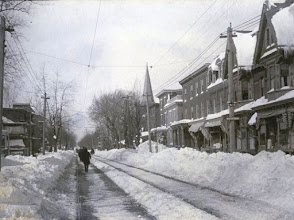Winter '09 / '10 - Quasi-biennial Oscillation
The Quasi-biennial Oscillation (QBO) is characterized by alternating easterly and westerly descending wind regimes at the equator. It dominates the variability of the tropical stratosphere. Although the QBO is a tropical phenomenon...it affects the stratospheric flow from pole to pole by modulating the effects of extra-tropical waves. [M. P. Baldwin et.al., 2001 (.pdf)]
The period of oscillation varies between 20 and 36 months...with an average period of about 28 months...as measured over the past half-century. The QBO index at each stratospheric level is the zonally-averaged zonal (east-west) wind. It is the most predictable inter-annual climate fluctuation on the planet.
August QBO @30mb is -14.46 (data)...three months into its nascent easterly phase. It/s expected to remain easterly through spring 2010...reaching its peak amplitude (< -25) during the heart of meteorological winter.
QBO is important b/c it determines the character of the early winter. The east phase leads to a more disturbed and warmer Arctic in December and January. During winter...QBO appears to excite the 'northern annular mode' (aka Arctic Oscillation [Thompson and Wallace, 1998 (.pdf), 2000]. Its easterly phase is represented in composites geo-potential...wind...and temperature fields by a weaker polar vortex (PV)...warmer polar temperatures...and higher geo-potential heights at hi-latitudes. In years with low solar activity...the winter PV tends to be disturbed and weak when the QBO is easterly.
Monthly sunspot activity YTD (data) has been anomalously quiet (lowest 10th percentile) 24 of the past 32 months and every month since April 2008. Top-5 sunspot analog years: 1913...1823...1811...1810...1912.
Reconstructed NAO index (Li) for '12/'13 is 1.44 and '13/'14 is 1.63... neither of which lend any support to a correlation between weak PVs with its implied -AO/-NAO and extremely low sunspot activity.
Top-5 sunspot analogs for years beginning 1950 and their D-J-F AO/NAO: 2008 (0.259/-0.08)...1954 (-0.717/-0.76)...1996 (-0.096/-0.07)...1964 (-1.125/-0.61)...1976 (-2.617/-1.04) supports the correlation.
Polar temperature varies out of phase with sunspot activity (low sunspot activity ==> warmer temperature ==> higher geo-potential heights) for winters when the QBO is easterly. Weak...'warm' PVs are less able to contain arctic air masses at hi-latitudes than cold...strong...less disturbed PVs. This suggests potentially favorable conditions this winter for arctic outbreaks leading to strong baroclinic zones developing between land and water which represent prime conditions for cyclogenesis and block-buster Nor'easters.
Easterly QBO also favors the occurrence of major winter stratospheric warmings [Holton and Tan (1980)(.pdf)]. Stratosphere warmings propagate from 10mb to the surface in ~3 weeks. Should such a warming occur mid-winter during QBO minimum...it could very well signal a cold end to meteorological winter.
-----
Should QBO play a dominant role this winter...
- Easterly phase during low solar activity ==> favors weak PV
- Weak PV ==> high heights @ hi-latitudes
- High heights @ hi-latitudes ==> negative northern annular modes (-AO / -NAO)
- -AO / -NAO ==> arctic outbreaks + increased east coast snowfalls
- Easterly phase favors major stratospheric warmings ==> lagged arctic outbreaks

QBO analogs YTD.
1991 is currently the leading analog. Winter '91 / '92 featured +ENSO (albeit one that became strong by spring)...+AO...+NAO...and -SOI...all of which go against type for -QBO. Did anonymously high (96th percentile) monthly sunspots play an active and deciding role?
EDIT: corrected sign of Winter '91 SOI.




































